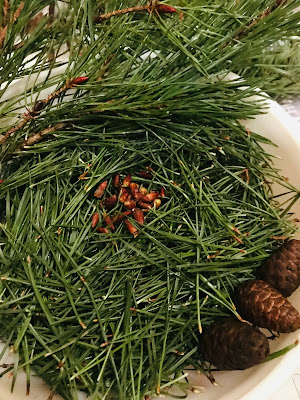Let's talk about pine! I got a bit excited in early March, when all my newly ordered foraging books seemed to be full of tips for making syrups and other goodies from pine or spruce. I immediately went on a mission to log all the places in my neighbourhood where these splendid (and, turns out, elusive!) coniferous trees could be found. Which threw up the first problem: my complete lack of conifer ID skills! I mean, I can safely identify a yew, which is a good start, seeing that its needles are deadly poisonous! But that's as far as it goes really. So I went to brush up on my conifers. I found this
video quite a useful guide on how to tell the difference between a pine, a fir, a spruce and a cedar. (If you'd like to also learn all about the benefits of evergreen teas, watch from the beginning. If you're just after the ID bit, start at 1:50 minutes in.)
It's been really enjoyable sharpening my ID skills in an area that had always baffled me. And to be honest, for the first month or so, I was still pretty much stumped whenever I was looking at anything other than a pine with its distinctive long needles. But now that I've been flexing that muscle for a while, stuff finally seems to be sinking in, and I've come up with a few ways of remembering what's what. For example - fir needles are flat, and cedars are cons (because of their very non-needly needles). Hey, I'm a linguist, so a good alliteration will always do it for me! We all have our own methods of learning, but whatever you do: never rely on only one source of information; get some good books; only pick things you have positively identified; and, as always: do pick responsibly!
If you're dealing with mature pine trees and are of average height like me, you'll probably find the branches slightly out of reach. Luckily, the day a friend and I went out, an epic
hail storm assisted us by knocking down some small branches cum needles. So I gathered up a few, hurried home and turned to my books. In
The Forager's Calendar, John Wright references a pine needle cough medicine which I had set my sights on. To be fair, now (April and May) would probably be a better time to go and do
a pine forage, rather than in early March. The young, upright 'candles' are just starting to
appear, which according to John Wright make for superior cough syrup ingredients. That hail storm might have given a bit of a clue that I was being over-eager! But nevermind - I had braved the elements, I had foraged my needles, and thus these potions had to be concocted!
Pine Cough Syrup
Good old John didn't really go in for any great detail or ratios, so I basically winged this one.
Here goes:
- Make a sugar syrup with one part water and two parts sugar.
- Put your washed needles in the syrup so that they're just about covered, and boil for 15 minutes.
- Strain out the needles, empty the cooled liquid into a jar and seal the jar.
- After two weeks, add vodka. How much, you ask? Who knows! I recommend prolific tasting until you hit on the right consistency!
- Give out virtuous bottles of 'cough medicine' to all your friends.
Pine Oil Muscle Rub
- Stick needles in a bottle or jar (contrary to what you can see in the picture below, wide-necked is best).
- Fill the jar with olive oil and leave to infuse for several weeks in a warm place, shaking regularly.
- Then strain out the needles and either go on to make a salve, or use it by itself as an oily rub!
At this point, a word about salve ingredients and ratios. Most recipes I've come across ask for oil and beeswax as the main ingredients. The ratio usually hovers around the 10:1 mark - so if you have 100ml of oil, use 10g of beeswax. I've found this a really useful rule of thumb which I have decided to stick with, not least because I got a bit tired of endlessly converting cups to ml and ounces to grams and so on, thanks to the myriad of recipes that are floating around online.
The 10:1 rule also seems to work well when bunging in additional ingredients. So for example, if you're using oil, beeswax and shea butter, you can use 100ml of oil, 10g of beeswax and 10g of shea butter.
Right. Now that we got the maths bit out of the way, the rest of the process goes like this:
- Heat
your infused oil and the beeswax pellets in a bain-marie (a pyrex jar
in a pan with an inch of simmering water works well) until the pellets
are completely dissolved. This may take longer than you think. Don't panic! And
keep stirring. See my dandelion flower salve escapade.
- Then add the shea butter and stir until dissolved.
- Take
the mixture off the heat and add essential oils if you're so inclined. I
used some eucalyptus & oregano oil for this one.
- Fill into jars, tins or any other receptacles you've got knocking about, and leave to cool completely (over night) before putting lids and labels on.
Et voilà. Tired muscles rejoice!




Comments
Post a Comment